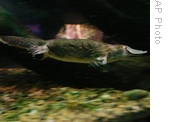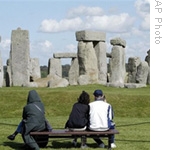VOA慢速英语-SCIENCE IN THE NEWS - A Genetic Map for One of the W
搜索关注在线英语听力室公众号:tingroom,领取免费英语资料大礼包。
(单词翻译)
Also: A study shows England's Stonehenge was used as a burial ground for 500 years. Transcript1 of radio broadcast:
16 June 2008
VOICE ONE:
This is SCIENCE IN THE NEWS in VOA Special English. I'm Bob Doughty2.
VOICE TWO:
 |
| A platypus3 |
And I'm Barbara Klein. This week, we will tell about a genetic4 study of one of the world's most unusual animals. We will tell about a health threat to cattle and the people who eat their meat. And, we share findings from a new report about a famous circle of stones in southern England.
(MUSIC)
VOICE ONE:
An international team of researchers says it has completed a genetic map for an unusual-looking animal: the platypus. For years, scientists have been interested in the platypus because it appears to be a mix of several different animals. The platypus has hair covering its body. But it also has a bill surrounding its mouth and webbed feet like a duck.
The researchers sought to understand how this strange creature developed by studying its genome, or full set of chromosomes5. The new, genetic map shows that the platypus has genes6 also found in both birds and reptiles7. The research team reported its findings last month in the publication Nature.
VOICE TWO:
The platypus is native to eastern Australia. The platypus is not endangered; however, people rarely see them. This is because the animals spend much of their time in underground passages along small rivers.
Although the platypus is considered a mammal, it is actually one of two animals known as monotremes. Both the platypus and the echidna are believed to have resulted from other mammals. Scientists believe this separation from more traditional mammals took place more than one hundred sixty million years ago.
The platypus is so unusual that when it was first sent to scientists in Europe in the nineteen century, they thought the animal was a joke.
VOICE ONE:
For the new study, the researchers examined genetic material from a female platypus they call Glennie. She lives in southeastern Australia. A goal of the study was to find which platypus qualities came from ancient reptiles, and which resulted separately in the development of monotremes.
The researchers found that the platypus genome includes some genes not found in other mammals. For example, it includes genes linked to production of eggs. These genes are shared only with reptiles and fish. The platypus also has genetic material for poisonous venom8 production similar to that of snakes. The venom is found in back legs of male platypuses9. The animal uses it to attack its enemies or other males.
VOICE TWO:
The platypus also carries mammalian genes for milk production. The animal does not have nipples, like most mammals, to feed its young. Instead, the platypus feeds milk to its young through skin on its abdomen10.
Among the surprises the research team discovered was genetic material responsible for sensitive odor receptors. Scientists had already known of the platypus' ability to identify electric fields of other animals underwater. The researchers believe the platypus uses the odor smelling ability to find its way underwater, for communication used in mating, or to hunt.
The study also found that the platypus genome is two-thirds the size of the human genome. Eighty-two percent of the animal's genes are shared with mammals.
(MUSIC)
VOICE ONE:
Bovine11 tuberculosis12 is a progressive wasting disease. It affects mainly cattle but also sheep, goats, pigs and other animals. People who get bovine TB have to take strong antibiotics13 for up to nine months to cure them.
People can get sick from infected cows by drinking milk that has not been heated to kill germs. Another risk is eating meat that has not been cooked to seventy-four degrees Celsius14. If an infected animal is processed, cutting through lung or lymph tissue can spread the M. bovis bacteria to other parts of the meat.
VOICE TWO:
Bovine TB is a major problem in parts of Africa. Farmers in Canada and Britain have also lost many cattle in recent years. In Britain, debate continues about whether badgers15 pass TB to other animals.
Infected cows might lose weight and develop a cough. The bacteria can spread from the sudden expulsion of air from the lungs. Or infected animals can appear healthy. Then, when they give birth, their milk can pass the infection to their young.
In the early twentieth century, bovine TB probably killed more animals in the United States than all other diseases combined. To control it, the government launched a successful testing program. Historians say animal doctors ordered the destruction of about four million cattle between nineteen seventeen and nineteen forty.
VOICE ONE:
The American state of Michigan has been fighting tuberculosis in cattle. Experts identified wild deer as the source of infection. The neighboring state of Minnesota and the western state of California have also had to deal with TB in cattle and deer.
Cows and wild deer can infect each other -- for example, if they share cattle feed left in fields during winter. Possible solutions might include building fences or leaving smaller amounts of hay.
VOICE TWO:
Experts say the most effective form of control is to destroy cattle herds16 that have been exposed to bovine tuberculosis. This prevents any chance that infected cows might be moved to another farm.
In April, the United States Department of Agriculture announced the availability of nearly seventeen million dollars in emergency assistance. The Department said the money is meant for programs to fight bovine TB in California, Michigan and Minnesota.
The states are to use the money to destroy cattle herds shown to have tuberculosis. The aid could also be used to study the affected17 groups and identify the cause of infection.
(MUSIC)
VOICE ONE:
 |
| Stonehenge |
Finally, new research suggests that England's Stonehenge served as a burial ground for hundreds of years. Stonehenge has long been of interest to archeologists and the public. Thousands of people visit the area each year.
In the past, archaeologists thought that burials at Stonehenge continued for only about one hundred years. Studies had shown human remains18 were buried there between four thousand six hundred and four thousand seven hundred years ago. That is about a century before the famously large stones were placed there.
VOICE TWO:
Recent tests of human remains show burials instead took place at Stonehenge over a period of about five hundred years. Researchers used radiocarbon dating tests to estimate the age of the remains. The researchers say the burials began there as early as three thousand years B.C., or about five thousand years ago.
The latest burial discovered was identified as a woman in her twenties. Her remains date back to around four thousand five hundred years ago. That is around the same time period when the huge stones, also known as sarsen, were put up.
VOICE ONE:
The latest research marked the first radiocarbon dating of human remains from the Stonehenge area. Scientists believe that as many as two hundred forty people were buried in the area. All of the human remains found there were burned before being buried in the ground.
Mike Parker Pearson is an archaeology19 professor at the University of Sheffield in England. He is also the head of the Stonehenge Riverside Project. The project is a seven-year archaeological investigation20 of Stonehenge. The National Geographic21 Society provided financial aid for the research. The team's findings are published this month in National Geographic magazine.
VOICE TWO:
Professor Parker Pearson says that scientists continue to debate questions like who built Stonehenge and why. He says evidence supports the theory that the area served as a burial ground for a single ruling family. He says thirty to forty generations were buried there. The number of remains grew over time. This suggests one family in which each generation included more family members. Because of this, Mister Parker Pearson believes it was not common people who were buried there. He says the remains are likely those of a royal family or one that ruled over the area.
Still, some scientists have other ideas about what the area was used for. They say that more research is needed.
(MUSIC)
VOICE ONE:
This SCIENCE IN THE NEWS program was written by Jerilyn Watson and Brianna Blake, who also was our producer. I'm Bob Doughty.
VOICE TWO:
And I'm Barbara Klein. Read and listen to our programs at voaspecialenglish.com. Join us again at this time next week for more news about science in Special English on the Voice of America.
 收听单词发音
收听单词发音 




